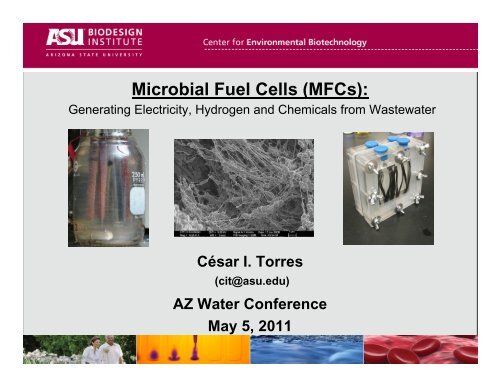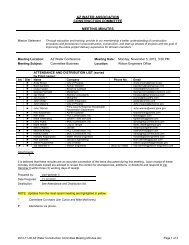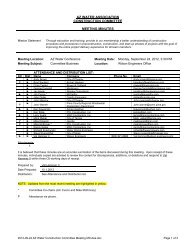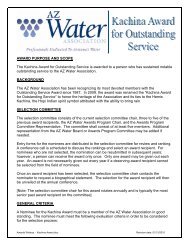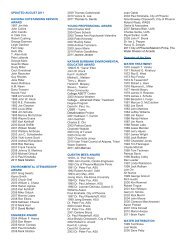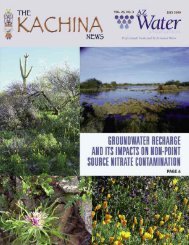Microbial Fuel Cells (MFCs): - AZ Water Association
Microbial Fuel Cells (MFCs): - AZ Water Association
Microbial Fuel Cells (MFCs): - AZ Water Association
Create successful ePaper yourself
Turn your PDF publications into a flip-book with our unique Google optimized e-Paper software.
<strong>Microbial</strong> <strong>Fuel</strong> <strong>Cells</strong> (<strong>MFCs</strong>):<br />
Generating Electricity, Hydrogen and Chemicals from Wastewater<br />
César I. Torres<br />
(cit@asu.edu)<br />
<strong>AZ</strong> <strong>Water</strong> Conference<br />
May 5, 2011
2<br />
MXC Team: César I. Torres, Bruce E. Rittmann,<br />
Rosa Krajmalnik-Brown, Andrew Kato Marcus,<br />
Prathap Parameswaran, Sudeep Popat, Joseph<br />
Miceli, Jon Badalamenti, Bradley Lusk, Abdul<br />
Hasam, Tyon Bry.<br />
Other collaborators: Dae Wook Kang, Anca<br />
Delgado, Junseok Chae, Seokheun Choi, Martina<br />
Hausner, Laura Berthiaume, Greg Wanger, Yuri<br />
Gorby.<br />
All EB team.<br />
Plus support from: ASU Biohydrogen Initiative,<br />
Open Cel, Office of Naval Research.
3<br />
Why <strong>Microbial</strong> <strong>Fuel</strong> <strong>Cells</strong>?<br />
• Chemical fuel cells are based on metal catalysts<br />
(expensive).<br />
• They are affected by impurities in the fuel/air<br />
• The reactions that can be catalyzed are rather<br />
simple:<br />
–H2→H + + e- –CH 3 OH + H 2 O→ CO 2 + 6H + + 6e -<br />
• They are very efficient, more efficient than<br />
combustion processes.<br />
• They reliably produce high power densities.<br />
H 2<br />
H +<br />
A<br />
n<br />
o<br />
d<br />
e<br />
e -
4<br />
Why <strong>Microbial</strong> <strong>Fuel</strong> <strong>Cells</strong><br />
• <strong>Microbial</strong> fuel cells take advantage of<br />
the diversity of microbial enzymes.<br />
– Anything anaerobic bacteria can consume<br />
will be converted into power in an MFC. Biofilm<br />
• This is what makes an MFC unique:<br />
Their capability to catalyze complex<br />
reactions and obtain energy from<br />
diverse chemical bonds!<br />
e -<br />
A<br />
n<br />
o<br />
d<br />
e<br />
e -
Our target wastes<br />
• We focus on wastewater and animal wastes,<br />
applying microbial fuel cell technologies.<br />
• Our target is to maximize energy capture from<br />
these waste streams.
• Anode Respiring Bacteria (ARB)<br />
ARB to produce electricity<br />
– Convert organic substrates and wastes into<br />
electrical energy<br />
• Excellent way to “concentrate” and transform<br />
the energy<br />
– A one-step process to obtain useful energy<br />
from bacterial processes – higher efficiency.<br />
– A new form of anaerobic respiration that<br />
allows the fast consumption of BOD in<br />
water.<br />
Biofilm<br />
e -<br />
A<br />
n<br />
o<br />
d<br />
e<br />
e -
7<br />
ARB in the Biofilm Anode<br />
• <strong>Microbial</strong> nanowires are thought to be the main way<br />
ARB transfer electrons to a solid anode.
8<br />
Finding ARB in nature<br />
• So far, few ARB isolates are able to produce high current<br />
densities, we look for more ARB capable of doing this.<br />
Carolina, PR<br />
Superior, <strong>AZ</strong><br />
Current Density (A/m 2 )<br />
Current Density (A/m 2 )<br />
10<br />
8<br />
6<br />
4<br />
2<br />
0<br />
0 2 4 6<br />
Time (days)<br />
8 10 12<br />
10<br />
8<br />
6<br />
4<br />
2<br />
0<br />
New media<br />
0 5 10 15 20<br />
Time (days)
9<br />
Biofilm Transport Limitation<br />
• We develop models to characterize how much electrical<br />
current is expected from a particular waste.<br />
• PCBIOFILM allow us to calculate the limit of substrate/H +<br />
transport limitation.<br />
Alk 0 (mgCaCO 3/L)<br />
5000<br />
4000<br />
3000<br />
2000<br />
1000<br />
0<br />
Donor Limitation<br />
0 100 200 300<br />
0<br />
400<br />
Effluent BOD (mg/L)<br />
20<br />
15<br />
10<br />
5<br />
Current Density (A/m 2 )
10<br />
Phototrophs as ARB<br />
• If EET is a ubiquitous process carried out by bacteria,<br />
some phototrophs must be able to perform EET.<br />
– Donate electrons to an anode at lower potentials,<br />
– Accept electrons from a cathode to fix CO2.
<strong>Microbial</strong> <strong>Fuel</strong> Cell (MFC)<br />
e- donor half reaction: CH3COO - 0.29 V<br />
- + 3 H2O → CO2 + HCO -<br />
3 + 8H + + 8e- e - acceptor half reaction: 2 O 2 + 8H + + 8e - → 4 H 2 O 0.81 V<br />
Net reaction: CH 3 COO - + 2O 2 → CO 2 + HCO 3 - + H2 O<br />
Electrical power<br />
generation<br />
1.10 V<br />
CH3COO M<br />
e<br />
m<br />
b<br />
r<br />
a<br />
n<br />
H2O e<br />
The reaction potential drives all biological, chemical, and electrochemical<br />
processes in MFC => typical recovered potentials are 0.3 - 0.6 V<br />
-<br />
¼O2 Air<br />
e- H + Anode Cathode<br />
+
<strong>Microbial</strong> Electrolysis Cell (MEC)<br />
e- donor half reaction: CH3COO - 0.29 V<br />
- + 3 H2O → CO2 + HCO -<br />
3 + 8H + + 8e- e - acceptor half reaction: 8H + + 8e - → 4 H 2 -0.41 V<br />
Net reaction: CH 3 COO - + 3H 2 O → CO 2 + HCO 3 - + 4 H2<br />
Anode<br />
CH 3 COO -<br />
H + +<br />
e -<br />
Due to the various types of electrochemical cells, we term this<br />
technology MXCs<br />
M<br />
e<br />
m<br />
b<br />
r<br />
a<br />
n<br />
e<br />
H 2<br />
-0.12 V<br />
H 2 gas<br />
production<br />
Cathode
Franks and Nevin, 2010<br />
MXCs – Current Applications
14<br />
CH3COO- CH3COO- H + H + + +<br />
e- e- M<br />
e<br />
m<br />
b<br />
r<br />
a<br />
n<br />
e<br />
Electrical power<br />
generation<br />
¼O 2<br />
H 2 O 2<br />
Air<br />
Cathode<br />
<strong>MFCs</strong> – WW Treatment<br />
• Our approach to wastewater<br />
treatment is to use an MFC to<br />
produce hydrogen peroxide (H 2 O 2 ).<br />
• Peroxide can be used to<br />
disinfect drinking water, plus the<br />
wastewater effluent.<br />
• It could be a key component to<br />
achieve water reuse remote<br />
locations.<br />
e- donor half reaction: CH3COO - 0.29 V<br />
- + 3 H2O → CO2 + HCO -<br />
3 + 8H + + 8e- e - acceptor half reaction: 4 O 2 + 8H + + 8e - → 4 H 2 O 2 0.28 V<br />
Net reaction: CH 3 COO - + 3 H 2 O + 4 O 2 → CO 2 + HCO 3 - + H2 O 2<br />
0.57 V
<strong>Microbial</strong> <strong>Fuel</strong> Cell (MFC)<br />
e- donor half reaction: CH3COO - 0.29 V<br />
- + 3 H2O → CO2 + HCO -<br />
3 + 8H + + 8e- e - acceptor half reaction: 4 O 2 + 8H + + 8e - → 4 H 2 O 2 0.28 V<br />
A<br />
Net reaction: CH 3 COO - + 3 H 2 O + 4 O 2 → CO 2 + HCO 3 - + H2 O 2<br />
Organic<br />
waste<br />
CO 2<br />
e- e- A<br />
n<br />
o<br />
d<br />
e<br />
M<br />
e<br />
m<br />
b<br />
r<br />
a<br />
n<br />
e<br />
Electrical power<br />
generation<br />
OH- OH- C<br />
a<br />
t<br />
h<br />
o<br />
d<br />
e<br />
O 2<br />
H H2O 2O 2<br />
e- e- A<br />
n<br />
o<br />
d<br />
e<br />
Organic<br />
waste<br />
CO 2<br />
H 2 O 2<br />
0.57 V<br />
Electrical power<br />
generation<br />
C<br />
a<br />
t<br />
h<br />
o<br />
d<br />
e<br />
O 2<br />
Diffusion<br />
Layer
• An important consideration when building MXCs<br />
is the need for a conductive biofilm support.<br />
H +<br />
Engineering MXCs<br />
– Carbon fibers can be used because of their high<br />
surface area and conductivity.<br />
A<br />
n<br />
o<br />
d<br />
e
Engineering MXCs<br />
• The engineering design can help increase MXC efficiency.<br />
• An MXC is a hybrid between a biological reactor and an<br />
electrochemical cell: careful design must accommodate<br />
both considerations.<br />
• A 125mL MEC produces<br />
~0.2 A and 2.1 L-H 2 /day.<br />
– This equals to<br />
17.5 L-H 2 /L-day<br />
Inner<br />
cathode<br />
H 2 gas out<br />
AEM<br />
Graphite or<br />
SS fiber<br />
anode<br />
Anode liquid<br />
outer flow
Engineering MXCs<br />
• Despite the improved engineering approach, wastewater<br />
feeds show other transport limitations that lead to lower<br />
current densities.<br />
Current density (A/m 2 )<br />
50<br />
40<br />
30<br />
20<br />
10<br />
0<br />
Ac<br />
-1<br />
Real wastewater (WW)<br />
Current density<br />
Applied voltage<br />
WW1 WW2 WW3 WW4<br />
0 50 100 150 200<br />
Time (day)<br />
Acetate-2<br />
8<br />
6<br />
4<br />
2<br />
0<br />
Applied voltage (V)
19<br />
MXC design<br />
• Maximize efficiency and optimize waste consumption.<br />
• Develop prototypes to be tested in the field.<br />
Anode<br />
liquid<br />
AEM and<br />
Pt/C Cathode<br />
Anode Chamber-<br />
Carbon or SS fiber<br />
Cathode<br />
Chamber-<br />
Air/CO 2 gas<br />
Cathode Air flow<br />
Z" (Imaginary), ohm<br />
2.5<br />
2.0<br />
1.5<br />
1.0<br />
0.5<br />
0.0<br />
0 2 4 6 8 10 12 14<br />
‐0.5<br />
Z' (Real), ohm
20<br />
Summary<br />
• ARB are fast consumers of BOD, potentially faster than<br />
aerobic organisms.<br />
• The main challenges in MXC implementation lie within the<br />
engineering design.<br />
• MXCs are currently tested for field-scale applications and<br />
this will lead to implementation in the near future.<br />
• A fundamental understanding of the chemical and biological<br />
processes is needed to design a feasible and efficient MXC.
21<br />
Torres Lab: César I. Torres, Sudeep Popat, Joseph<br />
Miceli, Bradley Lusk, Jon Badalamenti, Abdul<br />
Hamdan, Dongwon Ki.<br />
Other collaborators: Bruce E. Rittmann, Rosa<br />
Krajmalnik-Brown, Prathap Parameswaran,<br />
Daewook Kang, Anca Delgado, Nicole Hansmeier,<br />
Junseok Chae, Seokheun Choi, Martina Hausner,<br />
Laura Berthiaume, Greg Wanger, Yuri Gorby.<br />
Plus support from: Office of Naval Research, ASU<br />
Biohydrogen Initiative.


